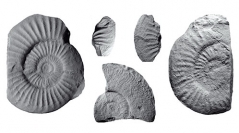

 Geodiversitas
29 (4) - Pages 473-506
Geodiversitas
29 (4) - Pages 473-506The paper describes and figures the ammonite and brachiopod faunas of the Pliensbachian exposed on the northern part of the Jebel Zaghouan (Poste Optique Mountain). These stratigraphically well located faunas have been collected in the thick Pliensbachian deposits of these area which represents an exception among the sedimentary context generally condensed of the Jurassic Tunisian Range (“Dorsale Tunisienne”). Ammonite communities comprise 18 species referred to Phylloceratoidea, Lytoceratoidea, Hildoceratoidea and Harpoceratinae. These faunas evidence 12 biostratigraphical horizons dated from middle Carixian up to late Domerian (Demonense Zone up to Emaciatum Zone).These horizons are easily correlated to the usual ammonite zonation of the Tethyan realm. A range chart showing the extension of the upper Pliensbachian ammonites summarizes the new data. Moreover, we must notice that the endemism tendency, observable up to middle Carixian, disappears from upper Carixian upwards. The latest Domerian (Emaciatum Zone) has also supplied brachiopods with alpine and sicilian facies (also called “brachiopod fauna of deeper and/or calmer sea floors” by Ager 1965: 162). These brachiopod species are described and figured for the first time on the Northern African Margin of the Tethys. These faunas with peculiar morphologies (axiform or not ribbed rhynchonellids, sulcate terebratulids and terebratellids) show a large but discontinuous distribution; they characterize distal environments located at the bottom of external platforms, on the border of basins splited up by a tilted-blocks tectonic.
Tethys, Tunisia, Lower Jurassic, ammonites, brachiopods, biostratigraphy, paleobiogeography